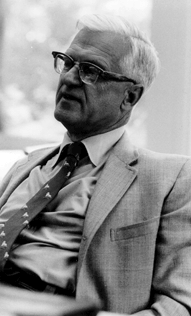Sherwood Washburn facts for kids
Quick facts for kids
Sherwood L. Washburn
|
|
|---|---|
 |
|
| Born | November 26, 1911 |
| Died | April 16, 2000 (aged 88) |
| Nationality | United States |
| Citizenship | United States |
| Alma mater | Harvard University |
| Known for | Comparative approach to understanding human evolution, renaissance of behavioral primatology |
| Awards | Viking Fund Medal, Huxley Memorial Medal and Lecture, Distinguished Service Award of the American Anthropological Association |
| Scientific career | |
| Fields | Anthropology |
| Institutions | Columbia University College of Physicians and Surgeons, University of Chicago, University of California, Berkeley |
| Doctoral advisor | Earnest A. Hooton |
| Doctoral students | Irven DeVore, F. Clark Howell, Vincent M. Sarich, Jane Lancaster, Ralph Holloway |
| Influences | W. T. Dempster, W. LeGros Clark, Alfred Romer |
| Notes | |
|
Designated by the AAPA as the premier American physical anthropologist of the twentieth century
|
|
Sherwood Larned Washburn (born November 26, 1911 – died April 16, 2000) was an American scientist. People often called him "Sherry." He was an expert in physical anthropology, which is the study of human origins and how humans have changed over time.
Sherwood Washburn was a pioneer in studying primatology, which means he was one of the first to study monkeys and apes in their natural homes. His work helped us understand how human behavior evolved by comparing it to how primates act. He changed the field of anthropology a lot. In 1951, he wrote an important paper called The New Physical Anthropology. In this paper, he showed that human differences are continuous, meaning you can't easily divide people into separate "races."
Contents
About Sherwood Washburn
Sherwood Washburn was born and grew up in Cambridge, Massachusetts. His father, Henry Bradford Washburn, Sr., was a dean at a school in Cambridge. Sherwood had an older brother named Bradford Washburn. When he was young, Sherwood loved learning about nature. During school breaks, he worked with animal exhibits at Harvard’s Museum of Comparative Zoology.
Education and Early Studies
Washburn graduated with the highest honors from Harvard University in 1935. He earned a bachelor's degree in Anthropology. He then continued his studies and received his Ph.D. in Anthropology in 1940. At first, Washburn thought about studying zoology, which is the study of animals. In his first year of graduate school, he worked on an animal expedition in Asia.
His studies helped him look at human evolution from many different angles. He learned about how animals are built, how they think, how they move, and about ancient life forms. This wide range of knowledge helped him understand human origins better.
Family Life
In 1938, Washburn married Henrietta Pease. They had two children, Sherwood "Tuck" and Stan. They lived in different cities like New York, Chicago, and Berkeley, California, where Washburn worked at universities. Sherwood Washburn passed away in Berkeley in 2000 when he was 88 years old.
Studying at Harvard
When Washburn started graduate school at Harvard, he planned to get a degree in zoology. However, his focus changed to anthropology after he took a class with a family friend, Alfred Tozzer. He found the mix of archaeology (studying old human history), customs (how people live), and human evolution very interesting.
He joined the physical anthropology program led by Earnest Hooton. Here, he could combine his zoology classes, like comparative anatomy and paleontology, with his study of human evolution. Washburn felt lucky that students had to look outside the anthropology department for training. This experience taught him how much more you can learn when different fields of study work together.
Fieldwork and New Ideas
While studying for his doctorate, Washburn got his first chance to do fieldwork. He worked as an assistant zoologist on an expedition to Asia in 1935–1936. In Malaysia, he helped collect samples of different types of monkeys, like colobine and macaque monkeys, and orangutans. In Sri Lanka and Thailand, he also collected lar gibbons and watched how they behaved in nature.
Washburn continued this work back at Harvard. He often talked with Gabriel Lasker about his findings. These discussions helped shape Washburn's ideas about human differences. He believed that human variation should be understood through population genetics (how traits are passed down in groups of people), not by old ideas of "races" or body types.
His main research for his doctorate looked at the measurements of skeletons from adult macaques and langur monkeys. In 1940, he earned his doctorate. This was the first time Harvard's anthropology department gave a degree for studying non-human primates.
Career Highlights
After graduating from Harvard, Washburn became a professor of anatomy at Columbia University College of Physicians and Surgeons. He worked there for eight years. From 1947 to 1958, he was a professor of anthropology at the University of Chicago. For a while, he was even in charge of the department.
Later, he moved to the University of California, Berkeley, where he became a professor. He stayed there until he retired in 1979. In 1975, the university gave him a special title called University Professor. Only a few people have received this honor.
Key Publications
Sherwood Washburn wrote many important books and articles. Here are some of them:
- Social Life of Early Man, published in New York, 1961
- "The Evolution of Man", an article in Scientific American in September 1978
- Human evolution: Biosocial perspectives, which he edited with Elizabeth McCown, 1978
- Ape Into Man; A Study of Human Evolution, published in Boston, 1973

